LP115
Location: Bet Bet
Australian Soil Classification: Endohypersodic-Endocalcareous, Epipedal, Grey VERTOSOL
General Site Description: Level plain with gilgai microrelief.
Geology: Basalt (Quaternary)
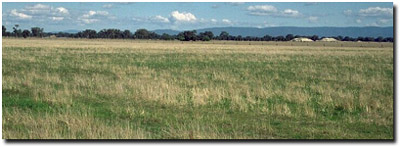 LP115 Landscape |
Soil Profile Morphology:
| Surface Soil | 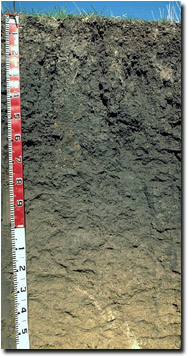 LP115 Profile | ||
| A1 | 0-10 cm | Very dark brown (10YR2/2), light medium clay; moderate medium sized blocky structure; very strong consistence (dry); rusty root channel mottles present; pH 6.7; abrupt change to: | |
| A2 | 10-20 cm | Dark greyish brown (10YR4/2), light medium clay; strong coarse blocky structure; strong consistence (slightly moist); most roots stop at 60 cm; pH 7.2; abrupt change to: | |
| Subsoil | |||
| B1 | 20-80 cm | Dark greyish brown (10YR4/2), medium clay; moderate very coarse prismatic structure, parting to strong coarse blocky and moderate fine blocky structure; very strong consistence (moist); pH 8.1; gradual change to: | |
| B21 | 80-110 cm | Very dark greyish brown (10YR3/2), medium clay; moderate medium sized polyhedral structure; firm consistence (moist); very few (< 2%) hard carbonates (av. 5 mm diameter); very few (< 2%) quartz gravels (av. 6 mm diameter); roots stop at 90 cm; pH 8.5; clear change to: | |
| B22 | 110-160 cm | Yellowish brown (10YR5/4), medium clay; moderate medium sized polyhedral structure parting to moderate very fine polyhedral structure; very firm consistence (moderately moist); band of soft carbonates runs at 450 angle across horizon. | |
Key Profile Features:
- Surface cracks and slickensides from 60 cm (vertic properties).
- Clay throughout entire profile.
- Band of carbonates runs across profile.
Soil Profile Characteristics:
pH | Salinity Rating | |||
Surface (A1 horizon) | Slightly acid | Very low | Non - sodic | None 1 |
Subsoil (B21 horizon) | Moderately alkaline | Very low | Sodic | Strong |
Deeper subsoil (at 110-160 cm) | Strongly alkaline | High | - | None |
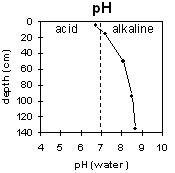 | 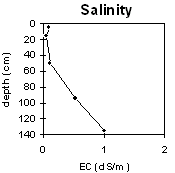 | 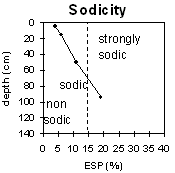 | 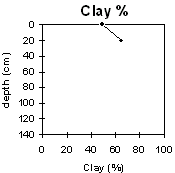 |
Horizon | Horizon Depth | pH (water) | pH CaCl2 | EC dS/m | NaCl % | Exchangeable Cations | Ex Al mg/kg | Ex Ac meq/100g | Field pF2.5 | Wilting Point pF4.2 | Coarse Sand (0.2-2.0mm) | Fine Sand (0.02-0.2mm) | Silt (0.002-0.02mm) | Clay (<0.002mm) | |||
Ca | Mg | K | Na | ||||||||||||||
meq/100g | |||||||||||||||||
A1 | 0-10 | 6.7 | 5.8 | 0.09 | 11 | 9.4 | 1.3 | 0.88 | 40.8 | 22.3 | 5 | 29 | 12 | 49 | |||
B1 | 10-20 | 7.2 | 5.8 | 0.05 | 9.4 | 8.5 | 0.93 | 1.1 | 34.8 | 17.9 | |||||||
B21 | 20-80 | 8.1 | 6.7 | 0.11 | 13 | 17 | 1.1 | 3.8 | 47.3 | 25.4 | 1 | 15 | 15 | 65 | |||
B22 | 80-110 | 8.5 | 7.6 | 0.53 | 0.12 | 12 | 16 | 1.2 | 6.5 | ||||||||
B23 | 110-160 | 8.7 | 8.1 | 1 | 0.12 | ||||||||||||
Whole Considerations
- Management strategies for all soils should aim to increase organic matter levels in the surface soil; minimise the degradation of soil aggregates and porosity; promote the development of stable biopores; improve the calcium status of the cation complex (when sodium is a significant part – i.e. sodic) and break up any hardpans. Less frequent tillage, using less aggressive implements, and working the soil at optimum moisture contents can all assist in maintaining soil aggregation and porosity as well as reducing the breakdown of organic matter.
- Plant Available Water Capacity (PAWC) is estimated to be medium (estimated at 130 mm) for the profile. This is based on available laboratory data and assumes an effective rooting depth of 80 cm. Rooting depth will be restricted by soluble salts at depth.
- The entire profile displays vertic properties (i.e. slickensides and deep cracking) which indicates that significant shrinking and swelling occurs. This may have implications for engineering purposes (e.g. disturbance to fencelines and foundations). As a result of these soil properties, gilgai microrelief is formed.
- Tillage of clayey soils like these should be avoided if the soil is wet (i.e. wetter than the plastic limit). At such moisture conditions, excessive tillage, trafficking or over-stocking could result in some structural degradation (e.g. compaction) occurring. Ideally, tillage should take place on clayey soils when the soil is drier than the plastic limit – down to at least the tillage depth.


